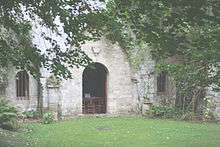Herluin de Conteville
Herluin de Conteville (1001–1066[2]), also sometimes listed as Herlwin of Conteville,[3] was the stepfather of William the Conqueror, and the father of Odo of Bayeux and Robert, Count of Mortain, both of whom became prominent during William's reign.[4] He died in 1066, the year his stepson conquered England.

Conteville and Sainte-Mère-Église
No contemporary record provides the parentage for Herluin,[5] although much later sources have assigned him parents (such as the otherwise unknown Jean de Conteville (965) and Harlette de Meulan). Herluin was a lord of moderate income and some land on the south side of the river Seine. He was viscount of Conteville, probably so created by his stepson, and held the honour of Sainte-Mère-Église, a portion of the county of Mortain. There he founded the Grestain Abbey around 1050 with his son Robert.[6]
Herluin's marriage to Herleva
Towards the beginning of the 11th century, Conteville and its dependencies appear to be in the hands of Herluin, who married Herleva, the mistress of Robert I, Duke of Normandy and already mother of William the Bastard, called William the Conqueror later. Herluin and Herleva had two sons and two daughters: Odo or Eudes, who became Bishop of Bayeux, and Robert who became Count of Mortain; both were prominent in the reign of their half-brother William. The daughters: Emma, who married Richard le Goz, Viscount of Avranches, and a daughter of unknown name, sometimes called Muriel, married Guillaume, Seigneur de la Ferté-Macé.[7] Herluin is said to have loyally borne Guillaume's body to his grave at Caen after he died in the burning of Mantes.[8]
Herluin's marriage to Fredesendis
Herluin later married Fredesendis, who is named as a benefactor[9] of the Grestain Abbey, and as Herluin's wife[10] in the confirmation charter of the abbey, dated 1189. The abbey was founded by Herluin himself around 1050,[9] in hopes of achieving a cure to his leprosy or some similar disease. Herluin and Fredesendis had two sons: Raoul de Conteville (d. aft. 1089), who later held land in Somerset and Devon,[11] and Jean de Conteville (who appears to have died young). Little is known of the sons of his second marriage.[5]
References
- "Herluin de Conteville (1001-1066) - Find A Grave..." www.findagrave.com. Retrieved 2020-06-03.
- David Bates, Normandy before 1066, (Longman Group, 1982), 119.
- Freeman, Edward A. (1902). William the Conqueror. New York: The Perkins Book Company. p. 277
- Freeman 1902, p. 15.
- Hollister, C. Warren (1987). "The Greater Domesday Tenants-in-Chief". Domesday Studies; Novocentenary Conference: Papers. Boydell & Brewer. p. 235. ISBN 0-85115-477-8.
- Freeman 1902, p. 112 and 382
- (FR) Jean Dubuc, Histoire chronologique de la Normandie et des Normands: des origines à 1204, (Inédits et introuvables, 2003), 556.
- Freeman, Edward A., William the Conqueror (1902), p. 276-277
- David C. Douglas, William the Conqueror (1964), p. 382
- The Normans in Europe, transl. & ed. Elisabeth van Houts, (Manchester University Press, 2000), 294.
- Jocelin of Wells:the making of a bishop in the reign of King John, Nicholas Vincent, Jocelin of Wells: Bishop, Builder, Courtier, ed. Robert William Dunning, (The Boydell Press, 2010), 14.
- Bates, David (1973) "Notes sur l'aristocratie normande: Hugues, évêque de Bayeux (1011 env. - 1049) et Herluin de Conteville et sa famille." Annales de Normandie 23 (1973): 7-38.